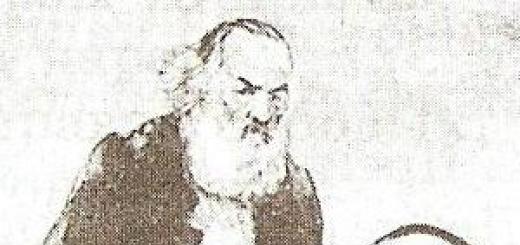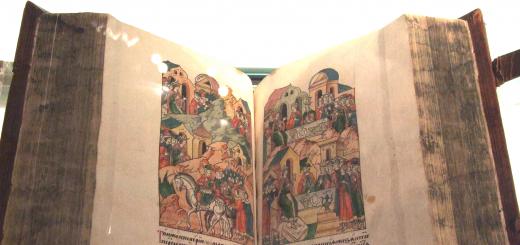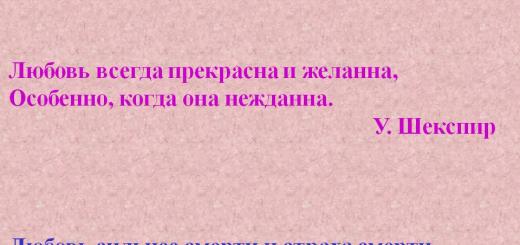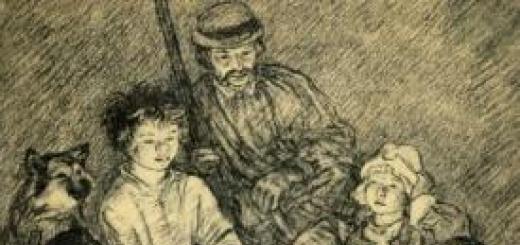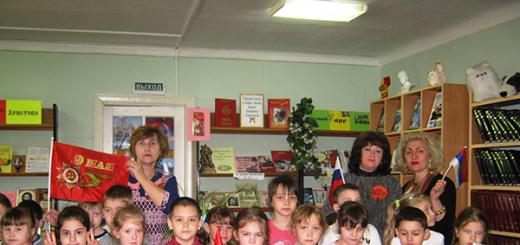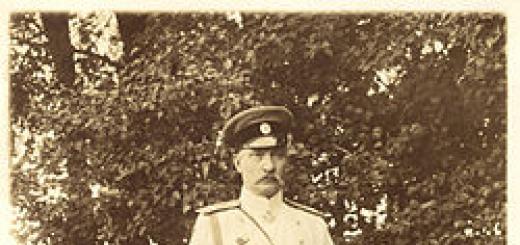
The image of the Middle Ages is often associated with the colorful figure of an armed knight in armor. Knights - professional warriors - were a corporation whose members were united by a way of life, moral and ethical values, personal ideals...
Knightly culture develops in a feudal environment. The camp of the feudal lords itself was heterogeneous. The small elite of the feudal class was created by the largest landowners - bearers of high-profile titles. These most noble knights, with the greatest pedigree, stood at the head of their squads, sometimes real armies.
Knights of lower rank served in these squads with their own detachments, appearing at the first call of the owner. At the lower levels of the knightly hierarchy were landless knights, all of whose property was contained in military training and weapons. Many of them traveled, joining the detachments of certain commanders, becoming mercenaries, and often simply engaged in robbery

Military affairs were the prerogative of the feudal lords, and they did everything to prevent “rude men” from participating in battles as much as possible. Carrying weapons and riding horses were often prohibited for “market traders, peasants, artisans and officials.” There were cases when knights refused to take part in battles along with commoners and infantry in general.
According to the spread of ideas among knights, a real knight had to come from a noble family. A self-respecting knight referred to a branched family tree to confirm his noble origin, had a family coat of arms and a family motto.
Belonging to the camp was inherited; in rare cases, they were knighted for special military exploits. The severity of the rules began to be violated with the development of cities - these privileges began to be purchased more and more often.
Different countries had similar systems for educating knights. The boy was taught horse riding, the use of weapons - primarily a sword and a pike, as well as wrestling and swimming. He became a page, then a squire to a knight. Only after this did the young man receive the honor of going through the rite of knighting.

Knighting (1322-1326). Simone Martini.
There was also special literature dedicated to the knightly “arts”. The future knight was taught, among other things, hunting techniques. Hunting was considered the second occupation worthy of a knight after war.
Knights developed a special type of psychology. The ideal knight had to have many virtues. He must be outwardly beautiful and attractive. Therefore, special attention was paid to clothing, decoration, and physique.
The armor and horse harnesses, especially the ceremonial ones, were real works of art. Physical strength was required from the knight, otherwise he simply would not be able to wear armor, which weighed up to 60-80 kg. Armor begins to lose its role only with the invention of firearms.
A knight was expected to be constantly concerned about his glory. Their valor had to be confirmed all the time, and many knights were constantly looking for new opportunities for this.
"If there's a war here, I'll stay here", said a knight in one of the ballads of the poetess Maria of France. There was nothing unusual about measuring strength with an unfamiliar opponent if he caused dissatisfaction in any way. Special knightly tournaments were organized. In the 11th-13th centuries, the rules of knightly tournaments were developed duels.

So, their participants had to use the same weapons. Most often, at first the rivals rushed at each other with a spear at the ready. If the spears broke, they took up the swords, then the mace. Tournament weapons were blunt, and the knights only tried to knock their opponents out of the saddle.
When holding a tournament, after many individual fights, which could last several days, the main competition was held - an imitation of a battle between two squads.
Knightly fights became an integral part of battles in endless feudal wars. Such a duel took place before the battle; the combat ended with the death of one of the knights. If the fight did not take place, then it was considered that the fight had started “not according to the rules.” Staunchy solidarity was developed among the knights. History knows many examples of truly knightly behavior.
During the war between the Franks and Saracens, one of the best knights of Charlemagne, named Ogier, challenged a Saracen knight to battle. When Ogier was captured by cunning, his enemy, not approving of such methods, himself surrendered to the Franks so that they could exchange him for Ogier.
During one of the battles during the Crusades, Richard the Lionheart found himself without a horse. His rival Sayf ad-Din sent him two war horses. That same year, Richard knighted his rival.

The highest manifestation of knightly love for war, the aggressive desire of feudal lords to seize new lands, supported by the Catholic Church, were the crusades to the East under the banner of protecting Christians and Christian shrines from Muslims.
The first of these occurred in 1096, and the last in 1270. During these events, special military-religious organizations emerge - knightly orders. In 1113, the Order of St. John, or Hospitallers, was founded. In Jerusalem, near the temple, there was the center of the Order of the Templars, or Templars. The order was ruled by the Grand Master, who submitted personally to the Pope.
Upon entering the order, the knights took oaths of obedience and humility. They wore monastic cloaks over knightly armor. The Teutonic Order played a major role in the aggression against the Slavic peoples.
The code of chivalry is reflected in knightly literature. Its pinnacle is considered to be the secular lyric poetry of the troubadours in the vernacular, which originated in the south of France. They create a cult of the Beautiful Lady, serving whom the knight must adhere to the rules of “courtiness”.
“Courtoisy,” in addition to military valor, required the ability to behave in secular society, maintain a conversation, and sing. A special ritual for marrying girls was developed. Even in love lyrics, in describing the feelings of a knight for his mistress, characteristic stan terminology is most often used: oath, service, gift, lord, vassal.

The genre of chivalric romance is also developing throughout Europe. His plot required ideal “knightly” love, military exploits in the name of personal glory, and dangerous adventures. The novels widely reflected the life and features of their time. At the same time, they already show a noticeable interest in the individual human personality.
The most popular stories are about the knights of the Round Table, the legendary King of the Britons Arthur, the knight Lancelot, Tristan and Isolde. Thanks to literature, the romantic image of a noble medieval knight still lives in our minds.
Knighthood as a military and landowning class arose among the Franks in connection with the transition in the 8th century from the people's foot army to the cavalry army of vassals. Having been exposed to the influence of the church and poetry, it developed a moral and aesthetic ideal of a warrior, and in the era of the Crusades, under the influence of the spiritual knightly orders that arose then, it became a hereditary aristocracy.
The strengthening of state power, the superiority of infantry over cavalry, the invention of firearms and the creation of a standing army by the end of the Middle Ages turned feudal knighthood into a political class of untitled nobility.
Deprivation of Knighthood
In addition to the knighting ceremony, there was also a procedure for deprivation of knighthood, usually (but not necessarily) ending with the transfer of the former knight into the hands of the executioner.
The ceremony took place on a scaffold, on which the knight's shield was hung on the reverse side (always with a personal coat of arms depicted on it), and was accompanied by the singing of funeral prayers by a choir of a dozen priests.

During the ceremony, after each psalm sung, a knight in full regalia was removed from a knight's vestment (not only armor, but also, for example, spurs, which were an attribute of knightly dignity).
After complete exposure and another funeral psalm, the knight’s personal coat of arms (along with the shield on which he is depicted) was broken into three parts. After which they sang the 109th Psalm of King David, consisting of a set of curses, under the last words of which the herald (and sometimes the king himself personally poured cold water on the former knight, symbolizing cleansing. Then the former knight was lowered from the scaffold using a gallows, the noose of which was passed under the armpits.
The former knight, under the hooting of the crowd, was led to the church, where a real funeral service was held for him, after which he was handed over to the hands of the executioner, unless he was sentenced to another punishment that did not require the services of an executioner (if the knight was relatively “lucky”, then everything could be limited to deprivation of knighthood).
After the execution of the sentence (for example, execution), the heralds publicly declared the children (or other heirs) “vile (literally vilans in French vilain / English villain), deprived of ranks, not having the right to bear arms and appear and participate in games and tournaments, at court and at royal meetings, under pain of being stripped naked and flogged with rods, like villans and born of an ignoble father.”

Such punishment was especially terrible for the German ministerials, since even as knights (with the prefix von) they were formally considered “serfs,” and deprivation of knightly dignity turned their descendants into real serfs.
Knightly virtues:
courage (pronesse)
loyalty (loyaut)
generosity
prudence (le sens, in the sense of moderation)
refined sociability, courtliness (courtoisie)
sense of honor (honneur)
liberty (franchisse)
Knightly commandments - to be a believing Christian, to protect the church and the Gospel, to protect the weak, to love one’s homeland, to be courageous in battle, to obey and be faithful to the lord, to speak the truth and keep one’s word, to maintain purity of morals, to be generous, to fight against evil and to defend the good and etc.
Later, the novels of the Round Table, trouvères and minnesingers poeticize the refined court knighthood of the 13th century. Among the ministerial horsemen and squires who deserved knightly spurs at the courts of the overlords, a cult of ladies could also arise.

The duty of obedience and respect towards the lord's wife, as a higher being, turned into worship of the ideal of a woman and service to the lady of the heart, mainly a married woman, standing in social position above the admirer.
The Hundred Years' War between France and England in the 14th century. introduced the idea of “national honor” among the knights of both hostile countries.
Human life in the Middle Ages was, in fact, a continuous test of endurance, although people were hardly aware of this, because they lived without knowing or even assuming a different reality. They lived as usual, as their fathers and great-grandfathers and great-great-grandfathers lived. The exception was, perhaps, the knights, in whose way of life certain changes did occur. At first, to be a knight simply meant to be a warrior, to perform vassal, usually equestrian, military service to his lord. However, in the endless medieval external and internal wars, a new ideology and psychology of chivalry was gradually formed; a fair amount of aristocracy and nobility, even some courtliness in the best sense of the word, was added to the image of an illiterate military man. The knight became not just a warrior, but a standard of noble aspirations and feelings; the concept of chivalry became synonymous with loyalty, which in medieval society was considered an almost unaffordable luxury. Even the king could not always boast of the loyalty of his own subjects, and what can we say about mere mortals?
The knights developed their own concepts of honor and nobility. First of all, the knight had to be a good Christian and was obliged to fight for the Christian faith and defend it everywhere. He had to protect the weak and always keep his word. The knight had to be loyal to his lord and had to be able to stand up for his life and dignity. And also, the knights’ skills in playing musical instruments, composing poems and poems dedicated to the Beautiful Lady, which every self-respecting knight simply had to have, turned out to be absolutely useful. At the same time, it should be noted that the Beautiful Lady had to remain unattainable for the knight. He could compose poems and songs in her honor, he could fight for her favorable glance in tournaments and perform God knows how many more military exploits on the battlefield, but the knight, as a rule, could not possess the lady of his heart. So, knights often chose married ladies as Beautiful Ladies and, according to all medieval rules of etiquette, praised their beauty and virtue, and sighed about them exclusively platonically. Even the queen could well become the Beautiful Lady of some glorious knight, because, as you know, even a cat is allowed to look at the king.
Of course, all the boys of the Middle Ages dreamed of becoming a knight. But this required a lot of work. Fifteen years is the most suitable age for a squire. It was at this age that boys entered the service of the knight, everywhere, like a shadow, following their master. The page-squires held the shield, provided spare weapons during the battle, and looked after the horses. After several years of service, the boy had matured and could already claim to be knighted. The night before initiation, the future knight had to pray all night on his knees, asking the Lord for strength and courage, nobility of thought, and perseverance, so that in the future he would have the courage not to disgrace the honorary title of knight. In the morning he confessed, performed a ritual ablution, put on the snow-white robes of a neophyte and, laying his hands on the Holy Gospel, solemnly swore to observe all the written and unwritten laws of chivalry. After this, one of the knights (or the young man’s father) took the sword out of its sheath and touched the neophyte’s shoulders with the blade three times. Then the young man was given his own sword, which he would never part with from now on. The one who knighted the boy hit him on the cheeks three times, saying: “Be brave!” and these were the only blows in the knight’s life to which he had no right to respond. Even the king, undergoing mandatory knighting, had no right to resist these ritual slaps. During the war, however, the ritual of knighting was somewhat more modest.
The knight spent almost all his free time either hunting or in war. - this is the nurse not only of knights, but also of any other warriors. By marauding in the occupied territories, people made themselves, if not a fortune, then at least somehow compensated for the long years of war deprivation. Another way for a knight to earn a living was jousting tournaments. This half-military - half-sports game, in which knights fought with each other, trying to knock the opponent out of the saddle with the blunt end of a spear. A knight thrown to the ground had to give his horse and his armor to the winner, but since it was considered a disgrace for a knight to remain without a horse and armor, the winner immediately returned his winnings to the loser for very good money (knightly armor cost approximately the same as a small became cows, heads, something like that, at 45). So, some knights earned their living by traveling from city to city and taking part in knightly tournaments, while glorifying the name of their Beautiful Lady in all cities.
(horsemen) in Ancient Rome. However, a fundamental change in the methods of waging war and organizing social relations in Europe is associated with the fall of the Roman Empire under the pressure of nomads from the east during the Great Migration of Peoples in the 4th-7th centuries. The heavy weapons of the Sarmatian cavalry and the long straight sword made of welded steel of the Hunnic type are obvious prototypes of the weapons of the medieval knights of Europe. Since it was the nomads (primarily the Sarmatians and Ostrogoths) who formed the dominant layer of society after the collapse of the union led by the Huns, it is logical to see the primary source of the differences between the European knightly culture of the Middle Ages and the culture of antiquity in the nomadic culture of the aliens. However, due to their relative small numbers, it took centuries for its influence to spread through synthesis with the local base.
Such punishment was especially terrible for the German ministerials, since even as knights (with the prefix von) they were formally considered “serfs,” and deprivation of knightly dignity turned their descendants into real serfs.
Knightly virtues
Knightly virtues:
- courage, bravery (fr. prouesse)
- fidelity, devotion (fr. loyauté)
- generosity (fr. largesse)
- prudence (fr. le senses)
- courtesy, courtliness, good manners in general (fr. courtoisie)
- honor (fr. honneur)
- liberty, freedom (complete personal independence, not counting duties to the overlord) (fr. franchise)
Knightly commandments - to be a believing Christian, to protect the church and the Gospel, to protect the weak, to love one’s homeland, to be courageous in battle, to obey and be faithful to the lord, to speak the truth and keep one’s word, to maintain purity of morals, to be generous, to fight against evil and to defend the good and etc.
Later novels " Round Table", Trouvères and Minnesingers poeticize the over-refined court knighthood of the 13th century. Among the ministerial horsemen and squires who deserved knightly spurs at the courts of the overlords, a cult of ladies could also arise; the duty of obedience and respect towards the lord's wife, as a higher being, turned into worship of the ideal of a woman and service to the lady of the heart, mainly a married woman, standing in social position above the admirer. The Hundred Years' War between France and England in the 14th century. introduced the idea of “national honor” among the knights of both hostile countries.
Weapons, tactics
In the XI-XII centuries. heavily armed knights protected themselves only with chain mail or scaled armor, and lightly armed horsemen went into battle completely without metal armor, protected only by leather quilting. In the 13th century, as the heavily armed cavalry stocked up on brigantines worn along with chain mail, later on greaves and bracers, knee pads, elbow pads and shoulder pads - which became common from the middle of the 14th century, chain mail appeared on lightly armed horsemen.
Each heavily armed knight took with him into battle three horses (usually of the destrie type) and one, two or three squires, who were usually recruited from dependents or sons of knights who had not yet been knighted. The squires initially went into battle on foot and remained behind during the battles, with spare horses and weapons. When in the XIV century. the custom of dismounting during battle took root among knights, then squires began to be recruited from light horsemen; The number of the knightly army began to be counted by “spears”, counting three horsemen per knightly spear. On the Rhine, the name “gleve” appeared for the same knightly unit ( glaive).
The usual formation for a detachment of knights in the Middle Ages was a wedge ( cuneus). Such a “wedge” could consist of several hundred knights, and sometimes several thousand. Most often, the entire knightly army lined up before the battle in three battle lines, one after the other, and each battle line broke up into “wedges” and had a center and two wings.
In connection with the military life of knights, knightly tournaments arose in France and from there they penetrated into Germany and England ( couflictus gallici).
Locks
Knights in popular culture
see also
| Knight in Wiktionary | |
| Knight on Wikimedia Commons |
Literature
- History of chivalry. Translation from French / Roy J.J.; Under. ed.: Fedorova N.M. – S.-Pb.: I.I. Ivanov, 1898. – 250 p. – reprint copy.
- Gautier. La Chevalerie. - P., 1884.
- Schreckenstein R. von Die Ritterwürde und der Ritterstand. - Freiburg im Br., 1886.
- Schulz A. Das höfische Leben zur Zeit der Minnesinger. - 1879-1880 (2. Aufl. - 1889.).
- Kohler Die Entwickelung des Kriegswesens und der Kriegführung in der Ritterzeit.
- Henne am Rhyn. Geschichte des Rittertums. - Leipzig.
- Cardini F. The origins of medieval knighthood. - M.: Progress, 1987. - 380 p.
- Roy J. J., Michaud J. F. History of chivalry. - M.: Eksmo, 2007. - 448 p. - ISBN 978-5-699-20223-2
- Flory J. Daily life of knights in the Middle Ages = Chevaliers et chevalierie au moyen age. - M.: Young Guard, 2006. - 400 p. - (Living History: The Daily Life of Humanity). - ISBN 5-235-02895-3
- Huizinga J. Knightly orders and knightly vows // Huizinga J. Autumn of the Middle Ages. - M., 1988. - P. 90-101.
Notes
Links
- Gureev M. V. Bibliography on the study of knightly culture and other social aspects of the Middle Ages (Electronic resource) // Portal of national prose of the Russian Federation
- Website about knights and the Middle Ages - articles and pictures
- About chivalry - Interesting articles about knights
| Parts of medieval armor | |
|---|---|
| Gousset Lamé Rondel | |
| Head | Helmets: Armet (a type of closed helmet) Barbute Norman helmet Bascinet (Hundsgugel variety) Burguignot Pot Helmet (Grand Slam and Sugarloaf varieties) Grand Bascinet Erichonka Toad head Iron hat Kabasset Capellina Misyurka Morion Salad Spangenhelm Shelom Shishak Balaclava Skull Cervelier Paper hat helmet details: Mask Nasal Visor Visor Browband Crest Crest (varieties of Sultan Helmet figure Yalovets Plumage) Burlet Headband Cheek pads Headband |
| Neck | Barmitsa Buviger (a variation of the Folding Chinrest) |
What girl doesn't dream of a beautiful knight? And I'm no exception. I imagined how a strong, brave and courageous prince on horseback would come to my house and make me the lady of his heart. And my knight found me, however, there was no horse. But is this important?
Who are knights
When you hear the word knight, everyone imagines a brave horseman with a sword in his hand. And that's true though real knights were far from ideal. Chivalry Start form approximately in the 8th century during the era of Charlemagne. These were heroes of their time, but only a man of noble family could become a knight. Idealized chivalric code sounded like this:
- defend the poor and weak;
- always be ready for battle;
- help those who cannot defend themselves;
- don't break promises;
- Homeland is more important than life.
But in reality, everything was not so beautiful. Knights owned castles and surrounding areas and themselves laid down laws. They are constantly fought wars with their neighbors and sometimes were no better than robbers and thieves. The code of honor required that the knight constantly perform feats. But the Crusades did not occur so often, so they became a good replacement tournaments. Here the knights showed their skills.

Everyone has it the knight had his motto and the lady of the heart, not necessarily free. Subsequently, chivalry began to grow stronger and has become an uncontrollable force. But the defeat of the Templar Order practically destroyed this elite military force, and knighthood lost its former power.
Ukrainian knights
Apparently no one will argue that Cossacks- a very interesting phenomenon not only in Ukrainian, but also in world history. These were talented warriors who defended not only their own lands, but also the lands of other countries. Their main law is honor and justice. The Cossacks loved entertainment and vodka. But drunkenness during campaigns was punishable by death.

Not only Ukrainians lived in the Sich, but also Poles, Belarusians, Moldovans and Russians. Cossacks traveled around the world, were interested in the culture of other countries and borrowed various fighting techniques. Cossacks, like European knights, had their own code. The main principles in it were love for the Motherland, care for women, children, the elderly, nobility, charity and freedom.

And among the Cossacks lived the so-called characterniki who are said to possessed magical powers. Neither a bullet, nor a saber, nor fire could take them. They could breathe underwater, see the future and turn into animals. Who knows if this is true or fiction. But the fact that Tothe azaks were real knights there is no doubt.
Knights are the aristocracy of the Middle Ages. At the end of the 10th century this title appeared. Honor, love of freedom, courage, loyalty, bravery - these were the virtues of knighthood.
Initially, men whose material well-being could only cause envy became knights. The knights wore heavy armor. The cost of the armor was 45 cows or 15 mares. Not every farm could boast of such wealth.
The knights had squires, who were either their sons or people from the lower strata of the “nobility”. The difference is that the children of knights subsequently underwent a rite of passage and became equal to their father, while unfree ones (those who cannot receive the title of knights and, accordingly, be considered free) remained so, that is, there were no development prospects .
Each knight had a horse - his faithful companion in battles, which served not only as a means of transportation, but also as military power. At the beginning of the 11th century, there were very few good archers, the weapons of the infantry were quite primitive, no one had even heard of firearms, so it turned out to be quite difficult to counteract the well-equipped gentlemen. There are military formations where knights were placed at the head of the column so that the infantry of enemy troops would receive damage from the horses.
Knights were officially recognized after the initiation ritual. It included the blessing of the sword by the Catholic Church and the girdling of it around the future protector of the king. There is the concept of colee - a blow to the back of the neck, which is also one of the stages of initiation.
The title could easily be lost for treason, non-compliance with the commandments of the knight, which read: “be a believing Christian, protect the church and the Gospel, protect the weak, love the homeland, be courageous in battle, obey and be faithful to the lord, speak the truth and keep your word.”
When deprived of a title, a simple removal of the title or execution by an executioner is possible. In the latter case, it was susceptible to popular ridicule. The son of a “well-established knight” could no longer become one of the privileged society.
Some knights (traitors to their masters) set up nests in their castles, whose purpose was to rob passers-by or neighbors.
The history of knights is multifaceted and interesting. Tournaments, crusades and much more from their culture are of considerable interest to the public to this day.
Report 2
Knighthood is an honorary title given only to nobles. As a military class, knighthood was formed in the 8th century by the Franks, during the transition from foot troops to a cavalry army. Under the influence of poetry and the church, the concept of “chivalry” was formed into the moral ideal of a real warrior. During the Crusades, knighthood became a hereditary aristocracy. Thanks to the strengthening of state power and the creation of troops, feudal knighthood in the Middle Ages was transformed into a political class.
In the Middle Ages, knights personified an indestructible and powerful force. Thanks to weapons, warriors were invincible. The shirt, made of metal with a hood and sleeves, reached the length of the knees, while fitting tightly to the body. The warriors' legs were covered with long chain mail stockings with spurs. The knights wore a pointed helmet over the hood. The iron headdress protected the warrior from blows during battles. The frame on the helmet protected the warrior's face. To repel enemy attacks and blows, warriors used a shield made of wood covered with leather. In addition to the shield, a wide sword with a thin handle was attached to the belt. Chivalry required financial security. Soldiers were given a land salary for their service. The knight bought equipment and weapons at his own expense. Equipment had up to 200 parts. The total weight of the armor could reach up to 50 kg. The preparation of knights included training and education. Until the age of 7, the boys lived with their own family. Then the education of future knights began. The training was not based on the study of science. Not all warriors of the Middle Ages could read and write.
Not every nobleman could become a knight. For certain merits, commoners could become warriors. At initiation, knights entered a certain class with familiarization with duty and rights. During the initiation rite, the initiate takes an oath of devotion to upholding a code of honor. The chivalric virtues included contempt for danger, military courage, respect for women, and pride. Stinginess and greed, the betrayal of the knight were not forgiven.
Campaigns and knightly exploits brought only dishonor and ruin to the common people. The seizure of booty during the war, cruel treatment of peasants, and robbery of merchants were considered the main source of income for the knights. In the Middle Ages, chivalry formed an international order. Despite title and wealth, members of the order were considered equals.
- Life and work of Arkady Averchenko
Arkady Timofeevich Averchenko is a Russian writer of satire and humor, born in Sevastopol, March 15, 1880. Arkady's father, Timofey Petrovich, was the successor of the merchant family, and his mother, Susanna Pavlovna, was the daughter of a retired officer.
Clay is a fossil that is formed from hard rocks. Parts of such rocks are gradually destroyed and then weathered, turning into small particles of approximately

